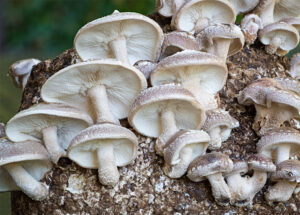Mushroom Spore Equipment: How to Grow Mushrooms From Spore
Are you interested in growing mushrooms from a spore syringe or print? It’s not as difficult as it sounds, and is by far the best way to get a hands-on mycology education. Our popular All-in-One Mushroom Grow Kit includes a pink oyster spore syringe, but you can of course use any kind of spores you want. Keep in mind that growing magic mushrooms is illegal in most jurisdictions, but in all states except for California, Georgia, and Idaho it is legal to purchase and own magic mushroom spores since at this stage of development they don’t contain psilocybin.
When growing mushrooms from spore, the most important part is to keep your work environment sterile. This is why our All-in-One kit comes with a “Clean Pak” that includes sterile wipes, gloves, a face mask, and more. It’s also why our mushroom grow bags have self-sealing injection ports. Learn more about mushroom cultivation with spores here.
Why Choose Monster Mushroom
Since Monster Mushroom Company went into business four years ago, we have worked tirelessly to use our expertise to deliver high-quality products and services to our customers consistently. We pore over every detail to ensure that beginners and experienced growers alike can cultivate mushrooms as smoothly as possible. Our spawn and substrates are completely sterilized to give you the best materials to grow your batch of mushrooms.
But great businesses don't just think about their products. They also think about the people who buy them. Monster Mushrooms makes it a point to take care of our customers with extensive care and a strong product warranty to ensure you get the most out of our offerings. Interested in mycology and don't know where to start? Check out any of the articles and videos in our Knowledge Center to learn the basics of mushroom growth.
What Our Growing Kit Comes With
Monster Mushrooms' All-in-One Grow Bag provides everything you need to grow several types of mushrooms at home. Our kits come equipped with meticulously sourced organic ingredients that stimulate quality growth and terrific yields without needing a ton of space. They also come with instructions that offer guidance for each step of the cultivation process. Our Grow Bags come in three and six-pound varieties.
A Step-by-Step on Growing Mushrooms from Spores
- Unpack your grow bag in a clean and stable environment. Be sure that the area is contaminant-free and has a stable temperature.
- Sanitize your hands and the needle of the syringe containing mushroom spores.
- Inject the spores into the bag through the self-healing injection port.
- Store the bag in a dark, warm place that encourages mushroom growth. Avoid disturbing the bag, as any disturbances can slow the mycelium colonization process.
- Once 60% or more of the grain layer has been colonized, it's time to break up the grain and mix it with the fruiting substrate. Try not to cut or damage the bag during this step. Your mushrooms should be ready to harvest in a couple of weeks.
- You can harvest mushrooms by twisting them at the base of a cluster or by cutting them. Mushrooms can exceed their peak harvest time over a single day, so keep a close eye on them so you can harvest them at the right time. Mushrooms should be harvested before their caps flatten or become recessed.
- Maintain the environmental conditions so you can grow more mushrooms in additional harvests.
Environmental Conditions to be Aware Of When Growing Mushrooms
The growth of mushrooms is affected by several environmental factors, such as:
- Light - Mushrooms don't use light as an energy source, but they do still need some light to grow properly. You can use natural or artificial lighting depending on the type of mushroom. If you use artificial lights, it is recommended that the lights stay for about 12 hours a day.
- Temperature - The temperature in your growth location is an important variable in how your mushrooms grow. The fruiting range for most mushrooms is between 60 and 80 degrees Fahrenheit. Staying near the higher end of the range can help encourage faster colonization. Mushrooms are also sensitive to sudden fluctuations, so make sure that you grow mushrooms in a place with a stable temperature.
- Air Quality - Mushrooms require fresh air circulation to cultivate and grow at a healthy rate. It's important to maintain balanced carbon dioxide levels to preserve mushroom quality.
Humidity - High humidity is essential for mushrooms, especially during the colonization and fruiting stages. If there isn't enough moisture in the air, mushrooms may not develop properly or have a shorter-than-expected shelf life. Regularly watering the substrate with water helps to keep the humidity high.

